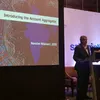SEBI's Madhabi Puri Buch lauds new account aggregator for potential to drive financial inclusion but cautions on biases
Madhabi Puri Buch, whole time member of SEBI, says she was a fan of the AA ecosystem because, on the one hand, it would democratise data and on the other, humanise transactions.
The launch of the new account aggregator (AA) platform by Aadhaar architect Nandan Nilekani in Mumbai on Thursday that promises to give users full control over how their data will be used is being hailed as a step in the right direction to bring about financial inclusion in India.
The new public digital infrastructure is the result of a collaboration between four major financial regulators: Reserve Bank of India (RBI), Securities and Exchanges Board of India (SEBI), Insurance Regulatory and Development Agency (IRDA) and Provident Fund Regulatory and Development Agency (PFRDA), who came together to allow regulated entities under their control to share data with user consent.

Madhabi Puri Buch (Photo courtesy: 'Business Standard')
The account aggregator platform promises to give users full control over how their data will be used, including the right to revoke their consent for use at any time.
In the long run, it is intended to make credit accessible to people who may not have been part of the credit ecosystem and help them become part of the formal financial system.
Nilekani, who was appointed Chairman of a high-level committee on digital payments by the Union government, emphasised that AAs were not allowed to see, store, or sell the data, only collect and transfer it. It is all done through APIs.
Madhabi Puri Buch, whole time member of SEBI, said she was a fan of the AA ecosystem because, on the one hand, it would democratise data and on the other, humanise transactions.
Speaking at the Closed User Group Account Aggregator event, Buch said,
“Homeland Security in the US issued a list of 10 things you should do if you get taken hostage. One of those top 10 things was humanise yourself by sharing data about yourself to your captor. That's to me is powerful because what that means is that even in a situation as adverse as being taken hostage, your personal data can make the difference between life and death.”
Referring to technology-driven inflection points in India’s history, Buch talked about how dematerialisation (de-mat) revolutionised the way cheque-clearing happened in India. Another was the launch of online-share-trading, the stock market equivalent of the ‘sachetisation’ that FMCG majors were implementing in rural India.
“You could buy one share of Infosys, and you could buy it on an online trading platform,” she pointed out, to applause from the audience.
“What we see in the securities market that could potentially create lift-off using the AA ecosystem is the whole concept of making services that have so far been reserved for the well-heeled, (also available) to every citizen of our country. We can leverage (technologies like) machine learning to help us deliver inclusion at the scale, deliver services that are available to less than 0.5 percent of the country’s population, to every single citizen in the country.”
Weeding out bias in technology
Buch admitted that there are risks within technologies as well – that machine learning and artificial intelligence, which are great for fostering diversity and inclusion, also tend to have an inherent bias in themselves.
“Either the data that is going is itself biased, or that the algorithms being built have a certain bias built into them. So that is a risk we must be very conscious of as we build out this ecosystem: how do we eliminate bias from the data and from the development of artificial intelligence and the algorithms…so that what we finally deliver to every citizen of the country the promise that the AAs hold out – is truly unbiased.”








